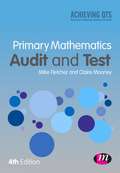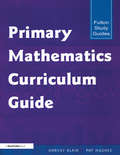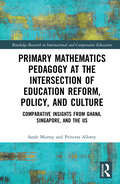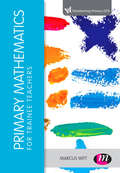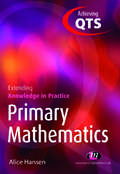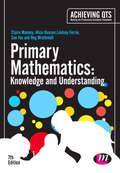- Table View
- List View
Primary Mathematics Audit and Test: Audit And Test (Achieving QTS Series)
by Claire Mooney Mike FletcherIf you are a primary trainee, you must demonstrate a knowledge of mathematics to be recommended for QTS. This popular, widely recommended text helps you audit your knowledge of mathematics and understand what learning you need to pass your course. A rigorous test helps you identify your strengths and weaknesses and can be revisited at key stages in your course as a tool to monitor and evaluate progress. The fourth edition has been updated in line with the new National Curriculum, includes more information on expanding and developing your knowledge of mathematics and is linked to the newest Teachers' Standards.
Primary Mathematics Curriculum Guide
by Pat Hughes Harvey BlairThis is a curriculum guide that gives trainee teachers the opportunity to follow a tried and tested primary mathematics curriculum course. The text is easy to follow, up-to-date with good current practice and utilizes materials produced by the DfEE for teachers. It includes interactive tasks to enhance understanding, tasks to consolidate learning at the reader's own level and pace, a full bibliography for further reading, common misconceptions which the reader will find in children's work, and a detailed look at the National Numeracy Strategy (NNS) and the mathematics National Curriculum. The text will provide a firm foundation for teaching mathematics to primary school children and give the reader genuine confidence in their teaching. The text has been piloted by students following a distance learning primary PGCE and revised in line with their comments. The intention of the book is to provide secure subject knowledge for mathematics alongside an understanding of the ways in which children learn mathematics.
Primary Mathematics Pedagogy at the Intersection of Education Reform, Policy, and Culture: Comparative Insights from Ghana, Singapore, and the US (Routledge Research in International and Comparative Education)
by Sarah Murray Princess AlloteyThis volume provides an in-depth, comparative examination of how primary mathematics education is influenced by national education reform, policy, local resources, and culture in three different countries. By drawing on first-hand observations and interviews, as well as analysis of policy documents and learning resources, the book considers the viability of transferring best practices in primary mathematics education across global contexts. Three diverse countries – Ghana, the US, and Singapore – are explored. Similarities and differences are highlighted, and the influence of national and regional initiatives related to pedagogical strategies, teacher education, and cultural expectations are considered, to offer an insightful examination of how best practices might be shared across borders. This book will benefit researchers, academics, and postgraduate scholars with an interest in international and comparative education, mathematics, and educational policy. Those with a specialization in primary mathematics education, including pedagogy and teacher preparation, will also benefit from this book.
Primary Mathematics Workbook 2A Standards Edition
by Kho Tek HongThe Primary Mathematics U.S. Edition series of elementary math textbooks and workbooks is meant to be part of a system of learning in which adult supervision and independent practice go hand in hand. The main feature of this series is the use of the Concrete-- gt Pictorial-- gt Abstract approach. The students are provided with the necessary learning experiences beginning with the concrete and pictorial stages, followed by the abstract stage to enable them to learn mathematics meaningfully. This approach encourages active thinking, communication of mathematical ideas and problem solving. This helps develop the foundation students will need for more advanced mathematics. Practice exercises are designed to provide the students with further practice after they have done the relevant workbook exercises. Review exercises are provided for cumulative reviews of concepts and skills. All the practice exercises and review exercises are optional exercises.Level 2A covers Numbers to 1000, Addition and Subtraction, Multiplication and Division, Length, and Weight.Format: Paperback, 112 pages Pubisher: Singapore
Primary Mathematics for Trainee Teachers (Transforming Primary QTS Series)
by Alice Hansen Marcus WittWith chapter sequencing following the new Curriculum, this book supports trainee Primary school teachers to make use of the opportunities presented in the new National Curriculum for effective and engaging Mathematics teaching. Covering all of the areas of the new Curriculum for primary mathematics and offering insight into effective teaching, this book helps students connect what they need to teach with how it can be taught. Exploring opportunities in the new curriculum for creative and imaginative teaching, it shows readers how to capitalize on opportunities to develop children′s reasoning and problem solving skills. It explores how to make links between mathematics and children′s lived experiences to enhance their learning and enables trainees to develop an ability to plan with discernment, making the most of existing thinking and research as well as building confidence in adapting and customizing ideas. Includes the full National Curriculum Programme of Study for Maths, key stages 1 and 2 as a useful reference for trainee teachers. Other books in this series include: and Primary English for Trainee Teachers
Primary Mathematics, Textbook, 1A, Standards Edition
by Marshall Cavendish International (Singapore) Private LimitedTextbook.
Primary Mathematics, Textbook, 1B, Standards Edition
by Marshall Cavendish International (Singapore) Private LimitedTextbook.
Primary Mathematics, Textbook, 2A, Standards Edition
by Kho Tek HongThe Primary Mathematics U.S. Edition series of elementary math textbooks and workbooks is meant to be part of a system of learning in which adult supervision and independent practice go hand in hand. The main feature of this series is the use of the Concrete-- gt Pictorial-- gt Abstract approach. The students are provided with the necessary learning experiences beginning with the concrete and pictorial stages, followed by the abstract stage to enable them to learn mathematics meaningfully. This approach encourages active thinking, communication of mathematical ideas and problem solving. This helps develop the foundation students will need for more advanced mathematics. Practice exercises are designed to provide the students with further practice after they have done the relevant workbook exercises. Review exercises are provided for cumulative reviews of concepts and skills. All the practice exercises and review exercises are optional exercises.Level 2A covers Numbers to 1000, Addition and Subtraction, Multiplication and Division, Length, and Weight.Format: Paperback, 112 pages Pubisher: Singapore
Primary Mathematics, Textbook, 2B, Standards Edition
by Jennifer HoerstThe Primary Mathematics Standards Edition is a series of elementary math textbooks and workbooks from the publishers of Singapore's successful Primary Mathematics series. Newly adapted to align with the Mathematics Framework for California Public Schools, the program aims to equip students with sound concept development, critical thinking and efficient problem-solving skills. Features of the series: Mathematical concepts are introduced in the opening pages and taught to mastery through specific learning tasks that allow for immediate assessment and consolidation. The modeling method enables students to visualize and solve mathematical problems quickly and efficiently. The Concrete > Pictorial > Abstract approach enables students to encounter math in a meaningful way and translate mathematical skills from the concrete to the abstract. The pencil icon provides quick and easy reference from the Textbook to the relevant Workbook pages. The direct correlation of the Workbook to the Textbook facilitates focused review and evaluation. New mathematical concepts are introduced throughout a spiral progression that builds on concepts already taught and mastered. Metacognition is employed as a strategy for learners to monitor their thinking processes in problem solving. Speech and thought bubbles provide guidance through the thought processes, making even the most challenging problems accessible to students. Color patch is used to invite active student participation and to facilitate lively discussion about the mathematical concepts taught. Reviews in the Workbooks for 1A-1B and regular reviews in the Textbooks and Workbooks for 2A-5B provide consolidation of concepts learned. The glossary effectively combines pictorial representation with simple mathematical definitions to provide a comprehensive reference guide for students. Answer keys booklets are not included, but are available - one for Primary 1A-3B and one for Primary 4A-6B.
Primary Mathematics, Textbook, 4A, Standards Edition
by Marshall Cavendish International (Singapore) Private LimitedTextbook.
Primary Mathematics, Textbook, 4B, Standards Edition
by Marshall Cavendish International (Singapore) Private LimitedTextbook.
Primary Mathematics, Textbook, 5A, Standards Edition
by Marshall Cavendish CorporationNIMAC-sourced textbook
Primary Mathematics, Textbook, 5B, Standards Edition
by Marshall Cavendish CorporationNIMAC-sourced textbook
Primary Mathematics, Workbook, 2B, Standards Edition
by Jennifer HoerstThe Primary Mathematics Standards Edition is a series of elementary math textbooks and workbooks from the publishers of Singapore's successful Primary Mathematics series. Newly adapted to align with the Mathematics Framework for California Public Schools, the program aims to equip students with sound concept development, critical thinking and efficient problem-solving skills. Features of the series: Mathematical concepts are introduced in the opening pages and taught to mastery through specific learning tasks that allow for immediate assessment and consolidation. The modeling method enables students to visualize and solve mathematical problems quickly and efficiently. The Concrete > Pictorial > Abstract approach enables students to encounter math in a meaningful way and translate mathematical skills from the concrete to the abstract. The pencil icon provides quick and easy reference from the Textbook to the relevant Workbook pages. The direct correlation of the Workbook to the Textbook facilitates focused review and evaluation. New mathematical concepts are introduced throughout a spiral progression that builds on concepts already taught and mastered. Metacognition is employed as a strategy for learners to monitor their thinking processes in problem solving. Speech and thought bubbles provide guidance through the thought processes, making even the most challenging problems accessible to students. Color patch is used to invite active student participation and to facilitate lively discussion about the mathematical concepts taught. Reviews in the Workbooks for 1A-1B and regular reviews in the Textbooks and Workbooks for 2A-5B provide consolidation of concepts learned. The glossary effectively combines pictorial representation with simple mathematical definitions to provide a comprehensive reference guide for students. Answer keys booklets are not included, but are available - one for Primary 1A-3B and one for Primary 4A-6B.
Primary Mathematics, Workbook, 4A, Standards Edition
by Marshall Cavendish International (Singapore) Private LimitedTextbook.
Primary Mathematics, Workbook, 5A, Standards Edition
by Marshall Cavendish CorporationNIMAC-sourced textbook
Primary Mathematics: Audit and Test
by Claire Mooney Mike FletcherThis book supports trainees on primary initial teacher training courses where a secure knowledge and understanding of mathematics is required for the award of Qualified Teacher Status (QTS). A rigorous test enables trainees to identify their strengths and weaknesses in mathematics and this can be revisited in order to monitor and evaluate progress towards QTS. Trainees are able to direct their studies more usefully and quickly develop confidence in topics they find difficult. This edition is fully up to date with the 2007 QTS Standards.
Primary Mathematics: Extending Knowledge In Practice (Achieving QTS Extending Knowledge in Practice LM Series)
by Alice HansenStill the biggest concern for many on initial teacher training courses is the acquisition of subject knowledge and the ability to translate that into effective teaching. This book addresses this - building on the core subject knowledge covered in the Achieving QTS series and relating it to classroom practice. It supports trainees in extending and deepening their knowledge of Maths and demonstrating how to apply it to planning and implementing lessons. Practical and up-to-date teaching examples are used to clearly contextualize subject knowledge. A clear focus on classroom practice helps trainees to build confidence and develop their own teaching strategies.
Primary Mathematics: Knowledge And Understanding (Achieving QTS Series)
by Claire Mooney Alice Hansen Lindsey Ferrie Reg Wrathmell Mrs Sue FoxThe Sixth Edition of this popular core text is the essential subject knowledge book for primary mathematics. Helping trainees to establish and consolidate a secure subject knowledge and understanding of primary mathematics, it promotes the development of confident, creative and effective teachers. This lates edition is linked to the 2012 Teachers' Standards. Providing full coverage of the required subject knowledge for primary mathematics, this is a core text for primary trainees working towards QTS. Self assessment questions enable readers to understand their own level of knowledge and an M level extension feature in all chapters suggests avenues for further study at Master's level. Research summaries include the latest works in primary mathematics and, throughout interactive tasks engage the reader with the text, helping them to link theory and practice. Trainees will find it helpful to use this book alongside Primary Mathematics Teaching Theory and Practice. About the Achieving QTS series All the books in this successful series support trainees through their initial teacher training and guide them in the acquistion of their subject knowledge, understanding and classroom practice. All new titles within the series link to the 2012 Teachers' Standards and take in to account recent changes in Initial Teacher Training.
Primary Mathematics: Knowledge And Understanding (Achieving QTS Series)
by Sue Fox Claire Mooney Alice Hansen Reg Wrathmell Lindsey DavidsonSecure subject knowledge and understanding is the foundation of confident, creative and effective teaching. To help your students master this, the 8th edition of this established text now comes with a range of online resources: Interactive Maths subject knowledge audit: to assess your students' overall performance and ensure they have an accurate picture of their ability. Reflective self-assessment questions: to help consolidate students’ understanding of each chapter topic and monitor their learning as they work through the book. Glossary: building students' knowledge of tricky terminology. Covering the whole primary curriculum, this edition also includes updated interactive activities throughout the book to engage students in their learning and enable discussion. Using this book in conjunction with the free online resources really makes this the complete package for developing Mathematics subject knowledge.
Primary Mathematics: Knowledge and Understanding
by Sue Fox Claire Mooney Alice Hansen Lindsey Ferrie Reg WrathmellThe 6th edition of this popular core text is the essential subject knowledge book for primary mathematics. Helping trainees to establish and consolidate a secure subject knowledge and understanding of primary mathematics, it promotes the development of confident, creative and effective teachers. This 6th edition is linked to the 2012 Teachers' Standards. Providing full coverage of the required subject knowledge for primary mathematics, this is a core text for primary trainees working towards QTS. Self assessment questions enable readers to understand their own level of knowledge and an M level extension feature in all chapters suggests avenues for further study at Masters level. Research summaries include the latest works in primary mathematics and throughout interactive tasks engage the reader with the text, helping them to link theory and practice. Trainees will find it helpful to use this book alongside Primary Mathematics Teaching Theory and Practice. About the Achieving QTS series All the books in this successful series support trainees through their initial teacher training and guide them in the acquistion of their subject knowledge, understanding and classroom practice. All new titles within the series link to the 2012 Teachers' Standards and take in to account recent changes in Initial Teacher Training.
